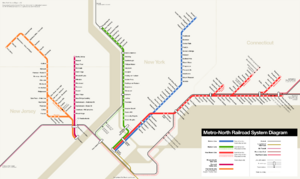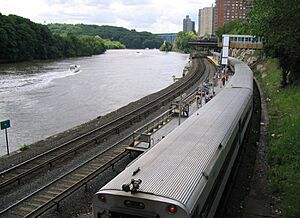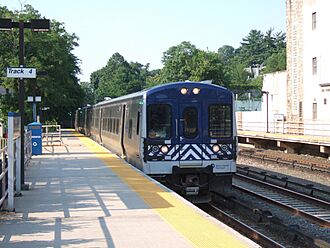Metro-North Railroad facts for kids
Quick facts for kids Metro-North Railroad |
|||
|---|---|---|---|
Sampler of Metro-North services NEW.jpg |
|||
| Info | |||
| Owner | Metropolitan Transportation Authority | ||
| Locale | Hudson Valley of New York; Southwestern Connecticut; Manhattan, The Bronx, North Jersey | ||
| Transit type | Commuter rail | ||
| Number of lines | 5 rail lines and 3 branches | ||
| Number of stations | 124 | ||
| Daily ridership | 189,500 (weekdays, Q1 2023) | ||
| Chief executive | Justin Vonashek | ||
| Headquarters | Graybar Building New York, New York |
||
| Operation | |||
| Began operation | 1983 | ||
| Operator(s) | Metropolitan Transportation Authority NJ Transit (west-of-Hudson) |
||
| Reporting marks | MNCW | ||
| Technical | |||
| System length | 787 mi (1,267 km) (385 mi (620 km), routes) |
||
| Track gauge | 4 ft 8 1⁄2 in (1,435 mm) standard gauge | ||
| Electrification | 750 V DC Overhead line, 12.5 kV 60 Hz AC |
||
|
|||
The Metro-North Railroad is a train service that helps people travel between New York City and its nearby suburbs. It runs trains in parts of New York, Connecticut, and New Jersey. This train system is managed by the Metropolitan Transportation Authority (MTA).
Metro-North connects many towns and cities. These include Poughkeepsie and White Plains in New York. In Connecticut, it serves places like Stamford and New Haven. It also provides local train service within Manhattan and the Bronx in New York City.
The history of Metro-North goes back to train services from the 1800s. The system as we know it today started in 1983. This was when the MTA took over commuter train services from another company called Conrail.
Metro-North has 124 stations on five main lines and three smaller branches. It uses over 787 miles (1,267 km) of track. It is the second busiest commuter train system in North America. Only the Long Island Rail Road carries more passengers each year.
Metro-North also works with NY Waterway to provide ferry services. These ferries connect to Metro-North stations in Beacon and Ossining.
Contents
Metro-North Train Lines
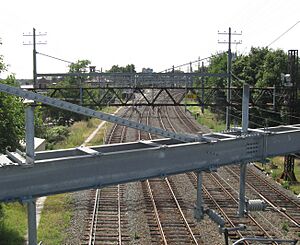
Metro-North has different train lines that serve various areas. Some lines are east of the Hudson River, and others are west.
Lines East of the Hudson River
Three main lines run east of the Hudson River. They all go to Grand Central Terminal in Manhattan. These are the Hudson, Harlem, and New Haven Lines.
Freight trains also use Metro-North tracks. However, Metro-North itself does not operate freight services. Other freight companies use these tracks to move goods.
Harlem Line: Your Route to Wassaic
The Harlem Line travels from Grand Central Terminal to Wassaic. This is in Amenia, New York.
This line has 38 stations, which is the most of any main line. Electric trains usually run on the southern part of the line. They go between Grand Central and North White Plains. Express trains often skip stops between Grand Central and White Plains.
North of Southeast, the Harlem Line uses diesel-powered trains. This part of the line has only one track. Passengers traveling to stations north of Southeast usually need to change trains there.
Hudson Line: Following the River
The Hudson Line runs along the Hudson River. It goes from Grand Central Terminal to Poughkeepsie, New York.
This line is divided at Croton-Harmon. Electric trains run south of this station. Diesel trains run north of it. Unlike the Harlem Line, diesel trains on the Hudson Line can go all the way to Grand Central. Electric trains typically make all local stops between Grand Central and Croton-Harmon. Diesel trains often run express to Croton-Harmon, then make local stops to Poughkeepsie.
New Haven Line: Connecting New York and Connecticut
The New Haven Line connects Grand Central Terminal to New Haven, Connecticut. This line is fully electric. It shares much of its track with Amtrak's Northeast Corridor.
The New Haven Line has an "inner zone" and an "outer zone" at Stamford. Inner zone trains stop at all stations between Grand Central and Stamford. Outer zone trains run express between Grand Central and Stamford. Then they make local stops between Stamford and New Haven.
This line also has three branch lines: the New Canaan, Danbury, and Waterbury Branches. The New Canaan Branch is electric. The Danbury and Waterbury Branches use diesel trains.
Lines West of the Hudson River
Metro-North also provides service west of the Hudson River. These trains run from Hoboken Terminal, New Jersey. They are operated together with NJ Transit.
There are two lines west of the Hudson: the Port Jervis Line and the Pascack Valley Line. The Port Jervis Line goes to Port Jervis, New York. The Pascack Valley Line ends in Spring Valley, New York. Most stops on these lines are in New Jersey. NJ Transit provides most of the trains and staff for these services. Metro-North also provides some equipment.
Connecting Ferry Services
Metro-North partners with NY Waterway for ferry services across the Hudson River. These ferries connect to the Ossining station and Beacon station. The ferries are the Haverstraw–Ossining Ferry and the Newburgh–Beacon Ferry.
How Metro-North Started
Early Train Services
Many of the train tracks east of the Hudson River were once part of the New York Central Railroad (NYC). The NYC had several commuter lines. Two of these lines went into Grand Central Terminal. The Harlem Line, for example, combined tracks from different railroads.
The New Haven Line, including its branches, was owned by the New York, New Haven and Hartford Railroad (NYNH&H). This company grew to be a very large passenger carrier in New England. In the early 1900s, the NYNH&H modernized its trains. It added electric and diesel power.
West of the Hudson River, today's Port Jervis and Pascack Valley lines were part of the Erie Railroad. These lines were built in the mid-1800s. Later, the Erie Railroad joined with another company to form the Erie Lackawanna.
The Penn Central Era
After World War II, passenger train services faced challenges. Commuter services often lost money. Many railroads started to stop their commuter lines. However, many New Yorkers still relied on trains for commuting.
In 1968, the NYC and the Pennsylvania Railroad joined to form Penn Central Transportation. The NYNH&H also became part of Penn Central in 1969. However, this large merger did not work out well. Penn Central declared bankruptcy in 1970.
The MTA then leased the Hudson, Harlem, and New Haven Lines from Penn Central. Penn Central continued to operate these lines under contract. In 1971 and 1972, the MTA and Connecticut Department of Transportation (ConnDOT) bought these lines.
The Conrail Years
In 1976, a new company called Conrail took over Penn Central's commuter routes. Conrail was created by the federal government. Many other railroads that went bankrupt also merged into Conrail.
By 1981, the government wanted state agencies to take over commuter train operations. This was because Conrail was planned to become a private freight-only company. So, states needed to operate and support their own commuter services.
Over the next few years, state agencies took control of commuter lines from Conrail. The MTA and ConnDOT officially took control of the Harlem, Hudson, and New Haven Lines on January 1, 1983. They merged them into the Metro-North Commuter Railroad.
MTA Takes Over and Modernizes
Metro-North also took over the former Erie Lackawanna services west of the Hudson River. Since these lines connect to NJ Transit, NJ Transit operates them. Metro-North helps by providing money and equipment.
Metro-North was created as a part of the MTA. The agency planned to make many improvements over the next five years. This included updating tracks, stations, and trains.
In March 1983, Metro-North employees went on strike for six weeks. This was due to disagreements over labor contracts. The strike ended in April when both sides agreed to a solution.
Metro-North worked hard to update and fix its infrastructure. This included stations, tracks, and trains. By the mid-1990s, the railroad became very successful. In 2006, Metro-North had a 97.8% on-time rate for its trains. It also had record ridership with 76.9 million passengers.
In 2018, the MTA bought Grand Central Terminal and parts of the Hudson and Harlem Lines. This secured the future of these important train routes.
How Metro-North Works
East of Hudson Train Power
Most trains going into Grand Central Terminal use electricity.
Diesel trains that go to Grand Central use special locomotives. These are called General Electric P32AC-DM locomotives. They can switch to run on electricity. These trains use a "third rail" system. This system provides 750 volts of direct current (DC) power.
On the Hudson Line, local trains use the third rail. Trains going to Poughkeepsie are diesel-powered. On the Harlem Line, the third rail goes to Southeast. North of Southeast, diesel trains are used.
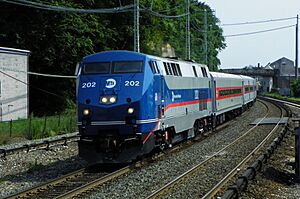
The New Haven Line is special because its trains use two types of electricity. They use the third rail and overhead wires called "catenary." The third rail is used from Grand Central to Mount Vernon East. Overhead wires are used from Pelham to New Haven. Trains can switch between these two power systems while moving. Special M8 trains are used on this line. They have equipment for both power types.
The New Canaan Branch also uses overhead wires. The Danbury and Waterbury Branches use diesel trains.
Metro-North uses a unique "under-running" third rail system. Power is collected from the bottom of the rail. This system helps insulate the rail from above. This makes it safer and reduces problems with ice in winter.
Train Signals and Safety
The Hudson, Harlem, and New Haven lines use a system called "cab signaling." This means the train's speed limit and signal information are shown right inside the engineer's cab. There are no regular signals along the tracks between stations. This helps engineers know the correct speed.
Metro-North also updated its Operations Control Center in Grand Central Terminal in 2010. This center manages all train movements.
West of Hudson Train Power
Most trains west of the Hudson River are Metro-North owned. They are operated by NJ Transit. These trains use diesel locomotives. Metro-North and NJ Transit share equipment for these lines.
Metro-North Trains
Metro-North uses different types of trains. The Harlem and Hudson Lines use M3A and M7 electric trains. These are similar to trains used on the Long Island Rail Road. The New Haven Line uses M8 electric trains. These can switch between third rail and overhead wire power. Diesel locomotives are used on parts of the network that are not electrified.
How to Pay for Your Ride
Metro-North offers many different ticket types. Prices depend on how often you travel and how far you go.
East of Hudson Fares
You can buy tickets at stations from a ticket office or machines. You can also buy them online or using phone apps. Monthly tickets can be delivered by mail. There is a small extra charge if you buy a ticket on the train.
Ticket types include One-way, Round-trip, 10-trip, Weekly, and Monthly passes. Special tickets are available for students and people with disabilities. Some tickets also have a MetroCard on the back for New York City subways and buses.
Tickets to or from Manhattan (Grand Central Terminal and Harlem–125th Street) have "peak" and "off-peak" prices. Peak fares are higher. They apply during busy weekday morning and evening hours. Off-peak fares are charged at all other times, including weekends and holidays. Tickets for travel only outside Manhattan are called Intermediate tickets and do not have peak fares.
Metro-North stations are divided into 14 zones in New York. Connecticut has a more complex fare system.
The MTA is replacing the MetroCard system with a new contactless payment system called OMNY. This system will allow you to pay with your phone or a special card. It will also be used on the Long Island Rail Road and Metro-North.
CityTicket: Travel within NYC
Since 2003, Metro-North and the Long Island Rail Road have offered a special "CityTicket." This allows passengers to travel within New York City for a lower price. It was first available only on weekends. In March 2022, it was expanded to include all off-peak trains during the week. As of July 2023, peak CityTickets cost $7. A pilot program starting in July 2024 offers a 10% discount on monthly tickets for trips entirely within New York City.
CityTicket is valid for trips that start and end within New York City. You must buy it before boarding the train.
| All Lines | Grand Central Terminal |
|---|---|
| All Lines | Harlem-125th Street |
| Hudson Line | Yankees-153rd Street |
| Hudson Line | Morris Heights |
| Hudson Line | University Heights |
| Hudson Line | Spuyten Duyvil |
| Hudson Line | Riverdale |
| Harlem Line | Melrose |
| Harlem Line | Tremont |
| Harlem/New Haven Lines | Fordham |
| Harlem Line | Botanical Garden |
| Harlem Line | Williams Bridge |
| Harlem Line | Woodlawn |
| Harlem Line | Wakefield |
West of Hudson Fares
All stations west of the Hudson River use NJ Transit's fare system. You can buy one ticket for travel between any two stations on either system.
Future Plans for Metro-North
East of Hudson Line Improvements
Hudson Line: New Stations and Expansion
In 2009, Metro-North opened Yankees–East 153rd Street station. This station offers direct trains on game days from all East of Hudson lines.
There have been discussions about extending the Hudson Line further north. However, this has sometimes faced opposition from local residents.
Harlem Line: Redevelopment and Safety
Plans are in place to redevelop the area around the Harlem Valley–Wingdale station. This will create a new neighborhood.
Extending the Harlem Line further north would require a lot of work. Tracks and stations that were removed years ago would need to be rebuilt.
In 2014, Metro-North announced plans to install security cameras at all stations on the Harlem and New Haven Lines. This was to improve public safety.
New Haven Line: Electrification and New Stations
Discussions are ongoing to re-electrify the Danbury Branch. There are also plans to extend it to New Milford. A new station in West Haven opened in 2013.
Connecticut officials are also studying how to increase freight service on the New Haven Line. This would help reduce the number of trucks on busy roads. Metro-North has been upgrading the overhead wire system on the New Haven Line.
Plans to extend the Waterbury Branch further northeast are also being discussed. This would bring train service to cities like Bristol and New Britain.
Penn Station Access Project
Metro-North is working on a big project called "Penn Station Access." This project will allow New Haven Line trains to go to Penn Station in Manhattan. Currently, these trains only go to Grand Central Terminal.
This project became possible after the East Side Access project was completed in 2023. East Side Access redirected some Long Island Rail Road trains to Grand Central. This freed up space at Penn Station for Metro-North.
New stations will be built in the Bronx for this service. These include stations at Co-op City, Morris Park, Parkchester/Van Nest, and Hunts Point. These stations will be accessible for people with disabilities. They will also have bike parking and connections to buses.
Construction for Penn Station Access began in December 2022. Service is expected to start in 2027 or later. During busy hours, there will be several trains per hour to Penn Station.
West of Hudson Line Plans
Metro-North has considered extending the Port Jervis Line to Stewart International Airport in Newburgh. This could help both commuters and travelers using the airport.
Train Incidents
- On February 17, 1987, a Metro-North train collided with an empty train in the Bronx. Twenty passengers had minor injuries.
- On April 6, 1988, two empty Metro-North trains collided in Mount Vernon, New York. An engineer died in this incident.
- On May 17, 2013, two trains collided in Bridgeport, Connecticut. This happened when an eastbound train derailed and blocked the adjacent track. At least sixty passengers were injured.
- On December 1, 2013, a train derailed in the Spuyten Duyvil area of the Bronx. Four people died and 65 were injured. The train was traveling too fast into a curve.
- On February 3, 2015, a train on the Harlem Line hit a vehicle at a railroad crossing in Valhalla, New York. Six people died and 12 were injured. The vehicle and train caught fire after the incident.
See also
 In Spanish: Ferrocarril Metro–North para niños
In Spanish: Ferrocarril Metro–North para niños
- Long Island Rail Road
- List of Metro-North Railroad stations
- Transportation in New York City
- Transportation in New York State


